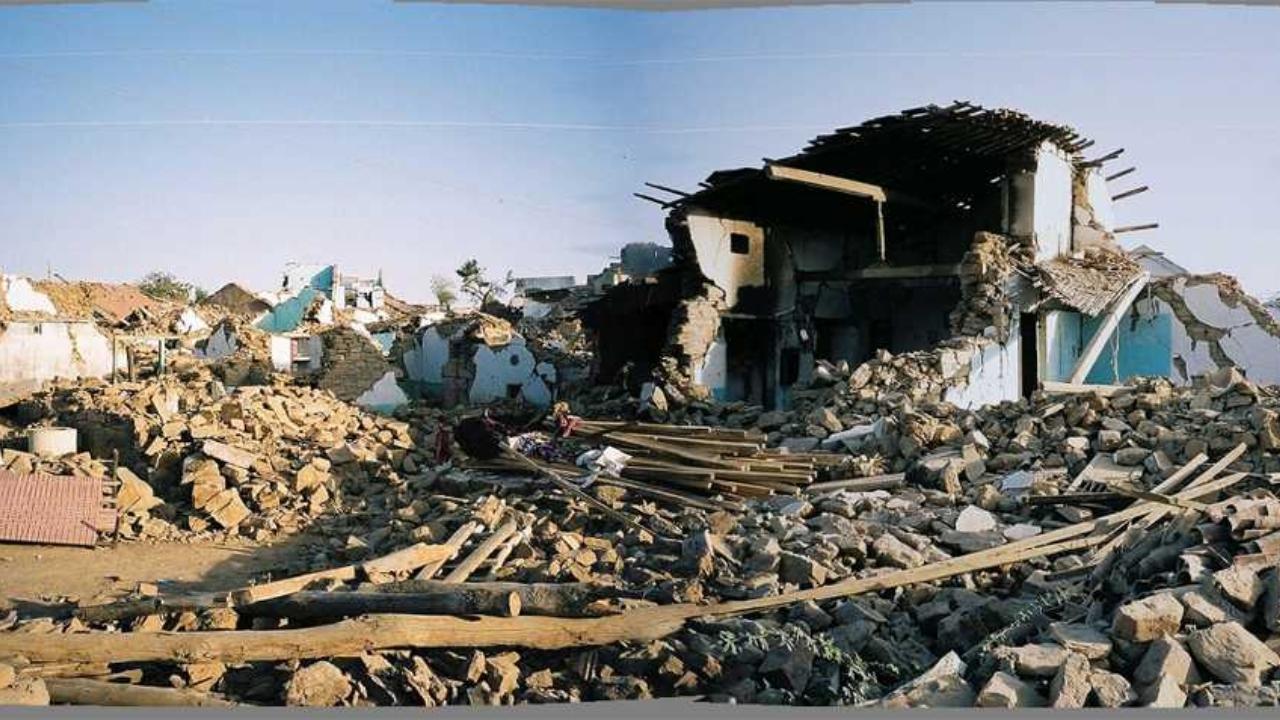As India was celebrating its 52nd Republic Day, on the morning of 26 January 2001, a massive earthquake hit Gujarat. About 13,800 people died,1,67,000 suffered injuries and nearly 1.2 million houses were damaged

2001 Gujarat Earthquake. Pic/Bhuj Area Development Authority
As India was celebrating its 52nd Republic Day, on the morning of 26 January 2001, a massive earthquake hit the western region of the state of Gujarat. The earthquake measuring 7.6 magnitude gave tremours even to the neighboring states and epicenter of the the devastating earthquake was Bhuj district in Gujarat. Because of which the disaster is also been called as Bhuj earthquake.
ADVERTISEMENT
As per Bhuj Area Development Authority, about 13,800 people died and 1,67,000 suffered injury. While nearly 1.2 million houses were damaged, and all the civic facilities like – schools, hospitals, health centers and public buildings suffered massive destruction. The utility infrastructures, which included water supply, electricity and telecommunications were also completely disrupted.
Worst natural disaster since independence
The disaster which affected over 37.8 million people were affected, including the neighbouring states of Gujarat and was the worst ever natural disaster since the independence of the country. The earthquake was followed by several aftershocks over the next few days.
The massive disaster not only created an national emergency situation but posed a severe challenge for the state of Gujarat to recover from its economic destruction. It was a humongous task for the government to bring life back to normal and provide required aid to the citizens. The four towns in Gujarat- the Kachchh-Bhuj, Bhachau, Anjar and Rapar suffered the maximum devastation. In Bhuj city itself, 2,370 people died, 3,187 suffered massive injuries, 11,036 houses were fully collapsed and 27,617 houses were partially collapsed, the government data says. The emergency-phase and service mode of the government ran till mid-March 2001.
Recovery and rehabilitation of Gujarat
To recover from the calamity, state government conceptualized a comprehensive rehabilitation and reconstruction program addressing concerns that arose from the earthquake starting from immediate relief, economic rehabilitation and livelihood restoration. The authorities prepared a 'Gujarat Earthquake Reconstruction and Rehabilitation Policy' which represented the reconstruction and rehabilitation plan for the state. Other objectives included the revival of the economy, health support, and reconstruction of the community and social infrastructure.
Financial aid poured in from around the world and a massive reconstruction and rehabilitation program was launched in the affected areas in Gujarat after the calamity. The World Bank and Asian Development Bank also provided loans worth 300 million USD and 500 million USD, respectively. Affected towns and villages were rebuilt with better housing. According to the Gujarat State Disaster Management Authority, 3,391 public buildings were repaired and 640 km of state highways and 3,061 km of rural roads were repaired.
Prime Minister Narendra Modi, who was then the chief minister of Gujarat, started the rehabilitation phase with an aim to 'build back better' with 'owner-driven reconstruction' to achieve the long-term goal for state's sustainability and development. In 2003, Gujarat also became the first state in India to enact the 'State Disaster Management Act' to provide legal and regulatory framework for effective disaster management.
The Act which clarifies the roles of principal stakeholders in disaster management, also became the blueprint for India’s Disaster Management Act, 2005, at the national level which further led to the creation of the National Disaster Management Authority (NDMA).
23 years later, Gujarat- one of the most industralised state in India, has not only made remarkable progress but marks an example of resilience.
 Subscribe today by clicking the link and stay updated with the latest news!" Click here!
Subscribe today by clicking the link and stay updated with the latest news!" Click here!







